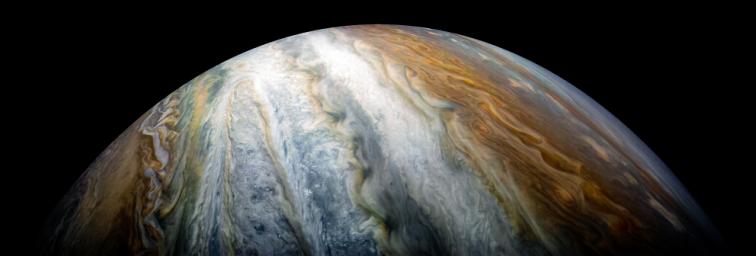
|
Jupiter’s Colorful Cloud Belts
- Click the image above for a larger view
- Full-Res JPEG (3805 x 1288) (587.0 kB)
- Full-Res TIFF (3805 x 1288) (9.6 MB)
Caption:
Colorful swirling cloud belts dominate Jupiter's southern hemisphere in this image captured by NASA's Juno spacecraft.
Jupiter appears in this color-enhanced image as a tapestry of vibrant cloud bands and storms. The dark region in the far left is called the South Temperate Belt. Intersecting the belt is a ghost-like feature of slithering white clouds. This is the largest feature in Jupiter's low latitudes that's a cyclone (rotating with clockwise motion).
This image was taken on Dec. 16, 2017 at 10:12 PST (1:12 p.m. EST), as Juno performed its tenth close flyby of Jupiter. At the time the image was taken, the spacecraft was about 8,453 miles (13,604 kilometers) from the tops of the clouds of the planet at a latitude of 27.9 degrees south.
The spatial scale in this image is 5.6 miles/pixel (9.1 kilometers/pixel).
Citizen scientist Kevin M. Gill processed this image using data from the JunoCam imager.
Background Info:
JunoCam's raw images are available at www.missionjuno.swri.edu/junocam for the public to peruse and process into image products.
More information about Juno is online at http://www.nasa.gov/juno and http://missionjuno.swri.edu .
NASA's Jet Propulsion Laboratory manages the Juno mission for the principal investigator, Scott Bolton, of Southwest Research Institute in San Antonio. Juno is part of NASA's New Frontiers Program, which is managed at NASA's Marshall Space Flight Center in Huntsville, Alabama, for NASA's Science Mission Directorate. Lockheed Martin Space Systems, Denver, built the spacecraft. Caltech in Pasadena, California, manages JPL for NASA.
Cataloging Keywords:
| Name | Value | Additional Values |
|---|---|---|
| Target | Jupiter | |
| System | Jupiter | |
| Target Type | Planet | |
| Mission | Juno | |
| Instrument Host | Juno | |
| Host Type | Orbiter | |
| Instrument | JunoCam | |
| Detector | ||
| Extra Keywords | Atmosphere, Color, Rotation, Storm, Visual | |
| Acquisition Date | ||
| Release Date | 2018-01-12 | |
| Date in Caption | 2017-12-16 | |
| Image Credit | NASA/JPL-Caltech/SwRI/MSSS/Kevin M. Gill | |
| Source | photojournal.jpl.nasa.gov/catalog/PIA21974 | |
| Identifier | PIA21974 | |
